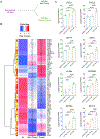Epithelialized tunnels are a source of inflammation in hidradenitis suppurativa
- PMID: 33548397
- PMCID: PMC8184580
- DOI: 10.1016/j.jaci.2020.12.651
Epithelialized tunnels are a source of inflammation in hidradenitis suppurativa
Abstract
Background: Hidradenitis suppurativa (HS), also known as acne inversa, is a chronic, painful, and burdensome inflammatory disease manifesting in nodules and abscesses, with progression to chronically draining tunnels in later-stage disease.
Objective: We sought to determine whether HS tunnels are immunologically active participants in disease activity.
Methods: Skin biopsy specimens were obtained by using ultrasound guidance in untreated patients with HS and those enrolled in an open-label study of brodalumab (ClinicalTrials.gov identifier NCT03960268) for patients with moderate-to-severe HS.
Results: Immunohistochemistry of HS biopsy specimens demonstrated that the epithelialized HS tunnels recapitulate the psoriasiform epidermal hyperplasia morphology of the overlying epidermis, displaying molecular inflammation, including S100A7 (psoriasin) positivity, as well as features of epidermal skin, including loricrin, filaggrin, lipocalin-2, and Melan-A positive cells. Tunnels were associated with increased infiltration of T cells, dendritic cells, and neutrophils; formation of neutrophil extracellular traps, and increased expression of psoriasiform proinflammatory cytokines. Unsupervised hierarchical clustering demonstrated a separation of HS samples based on the presence or absence of tunnels. Tunnels isolated by microdissection had higher levels of epithelium-derived inflammatory cytokines compared with the overlying epidermis and healthy controls. Clinically, the size and draining of the tunnels were decreased with treatment with the IL-17RA antagonist brodalumab.
Conclusion: These data suggest that tunnels are a source of inflammation in HS.
Keywords: Hidradenitis suppurativa; IL-17; brodalumab; neutrophils.
Copyright © 2021 American Academy of Allergy, Asthma & Immunology. Published by Elsevier Inc. All rights reserved.
Conflict of interest statement
Figures





References
-
- Sabat R, Jemec GBE, Matusiak L, Kimball AB, Prens E, Wolk K. Hidradenitis suppurativa. Nat Rev Dis Primers. 2020;6(1):18. - PubMed
-
- Ring HC, Bay L, Nilsson M, Kallenbach K, Miller IM, Saunte DM, et al. Bacterial biofilm in chronic lesions of hidradenitis suppurativa. Br J Dermatol. 2017;176(4):993–1000. - PubMed
-
- Deckers IE, Kimball AB. The Handicap of Hidradenitis Suppurativa. Dermatol Clin. 2016;34(1):17–22. - PubMed
-
- Gooderham M, Papp K. The psychosocial impact of hidradenitis suppurativa. J Am Acad Dermatol. 2015;73(5 Suppl 1):S19–22. - PubMed
Publication types
MeSH terms
Substances
Associated data
Grants and funding
LinkOut - more resources
Full Text Sources
Other Literature Sources
Medical
Research Materials

